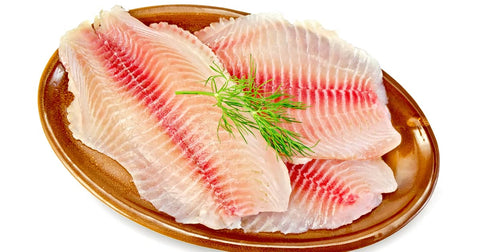Tilapia has become one of the most consumed fish in the United States, often praised for being affordable, lean, and easy to cook. But beneath the surface of this popular fish lies a wave of controversy and several compelling health concerns. If you’ve ever asked yourself, should I be eating tilapia?, this article will help you understand 5 reasons why you should never eat tilapia, especially if you value quality nutrition, environmental sustainability, and long-term health.

While tilapia offers a decent source of protein, the way it's farmed, processed, and sourced raises several red flags. Let’s dive into what makes this fish so controversial and why it might not be the healthiest choice for your plate.
1. Poor Farming Conditions and Questionable Origins
Where does tilapia come from?
Most tilapia sold in the U.S. is farmed, not wild. Countries like China and Indonesia dominate global tilapia production, often raising fish in overcrowded, low-quality environments where water contamination is common. These operations are far from the clear lakes and streams consumers often picture.
Because tilapia are omnivores that can survive on waste or low-grade feed, they are often raised in unsanitary ponds treated with antibiotics and chemicals to prevent disease. This leads to higher risks of consuming toxins, pesticide residues, and antibiotic-resistant bacteria.
If you do opt for tilapia, always look for wild caught tilapia, which is rare and usually more expensive but far cleaner.
2. Unbalanced Fatty Acid Profile
Unlike wild fish like salmon or sardines, tilapia is extremely low in omega-3 fatty acids and high in omega-6 fatty acids the kind that promotes inflammation when consumed in excess.
This imbalance may contribute to:
-
Increased risk of cardiovascular disease
-
Joint inflammation
-
Autoimmune flare-ups
-
Poor skin health
So while tilapia protein content may be decent, its nutritional profile lacks the anti-inflammatory benefits that most people seek in eating fish.
3. Is Tilapia Man Made? The Genetic Debate
There’s an ongoing question in consumer circles: is tilapia man made?

The answer is nuanced. Tilapia is not genetically engineered in the same way as GMO crops, but many strains especially the Nile tilapia have been selectively bred and hybridized for fast growth and disease resistance. These fish are far removed from their wild ancestors, and their commercial breeding raises concerns about long-term genetic manipulation, biodiversity, and resilience.
Additionally, many consumers are unaware of this hybridization and assume their fish is wild or natural, which often isn’t the case.
4. Questionable Nutrient Density Despite High Protein
How much protein in tilapia?
A 3.5-ounce serving of tilapia provides roughly 23 grams of protein, which is comparable to other white fish. However, that’s where the benefits plateau.
Looking deeper into tilapia nutrition facts, the fish is:
-
Low in healthy fats
-
Low in vitamin D
-
Often lower in selenium and B12 compared to other fish
In other words, you're getting protein without the protective nutrients that usually accompany quality seafood. You’d be better served nutritionally by wild-caught salmon, sardines, or mackerel.
5. Tilapia May Trigger Food Sensitivity in Some People
While tilapia is not a common allergen, it can still contribute to digestive upset, bloating, headaches, or fatigue in people with undiagnosed food intolerance.
Factors that contribute to food sensitivity with tilapia include:
-
Residual chemicals or antibiotics from farming
-
Poor digestibility due to protein structure
-
Immune response to additives in farm-raised fish feed
If you feel unwell after eating fish especially farmed fish like tilapia it’s worth considering a food sensitivity test kit. These tests can help identify immune reactions to specific proteins or additives, allowing you to make better choices that support digestion and energy.
What Does Tilapia Taste Like?
If you’ve never tried tilapia and are still curious, here’s what to expect: tilapia has a mild, somewhat bland taste that takes on the flavor of whatever it’s cooked with. This makes it easy to season, but also reflects its lack of natural oil and flavor depth, which is common in wild-caught or fatty fish.
Unfortunately, that mild taste is often the result of rapid growth in controlled environments, which strips the fish of its natural complexity and fatty richness.
Final Thoughts: Should You Avoid Tilapia?
Here’s a recap of the 5 reasons why you should never eat tilapia:

-
Poor farming conditions expose you to pollutants, chemicals, and antibiotic residue.
-
Unfavorable omega-6 to omega-3 ratio promotes inflammation.
-
Hybridized strains raise questions about the natural origin of the fish.
-
Limited nutritional density offers little beyond basic protein.
-
Potential food intolerance concerns from chemicals or feed ingredients.
If you're focused on long-term health, anti-inflammatory nutrition, and transparency in food sourcing, tilapia may not be the best fish for your table.
For a healthier alternative, opt for wild-caught fish like salmon, trout, or sardines or consult your healthcare provider about how your body is responding to certain proteins.
Worried that tilapia might be causing digestive issues, skin problems, or fatigue? Take a food sensitivity test kit and get clarity on how your body reacts to specific foods, including seafood.
Frequently Asked Questions (FAQs)
1. What does tilapia taste like?
Tilapia has a mild, neutral flavor that’s often described as bland. It lacks the richness and character of fattier, wild-caught fish.
2. How much protein in tilapia?
A standard serving (about 3.5 oz) of tilapia contains around 23 grams of protein.
3. Is tilapia man made?
Tilapia is not genetically modified, but many farmed varieties have been selectively bred, making them far from their wild counterparts.
4. Where does tilapia come from?
Most tilapia is farmed in countries like China and Indonesia, where environmental and health standards vary.
5. Can tilapia cause food intolerance?
Yes. While not a common allergen, some people react to tilapia due to farming conditions, feed, or protein structure. A food sensitivity test kit can help identify issues.


.png?v=1737390083)
.png?v=1737187409)


